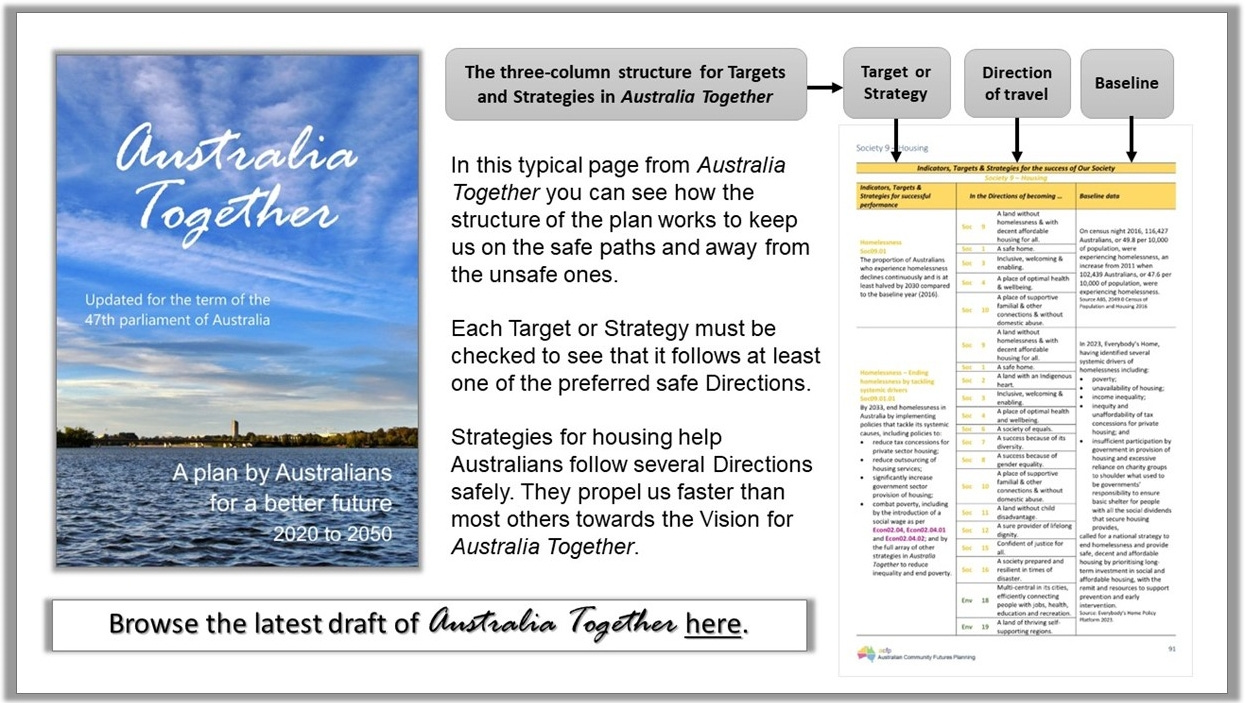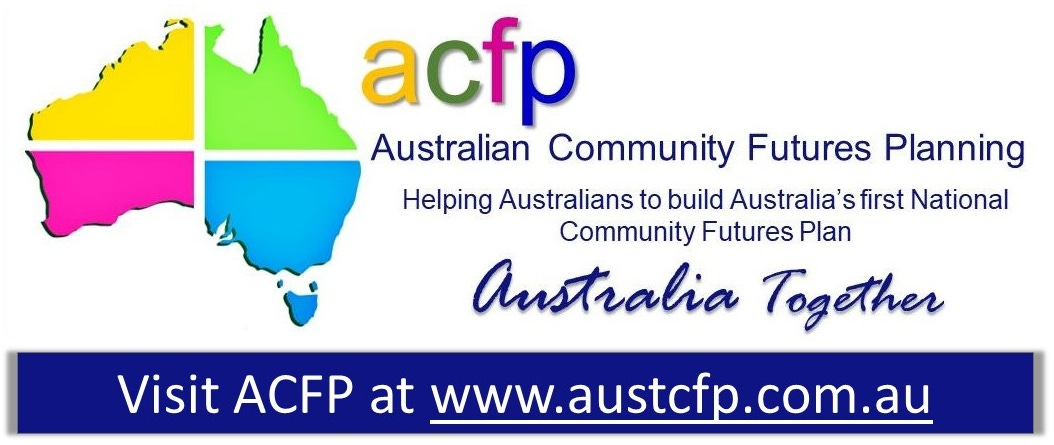Australia Together is the nation’s first long term, integrated plan for a better future for everyone. It is being progressively developed by Australians for Australians so that we can tell our governments what we want them to do for us as a cohesive, democratic community.
Issue No. 7 of Australia Together, released in February 2024, contains data and factual information on 312 indicators of the nation’s current wellbeing and security. These facts do not as a whole indicate that Australia is as safe and happy a place as we hope it will be. It’s not even close. There is much to be done to overcome challenges such as climate change, growing poverty and inequality, fractious international relations, and unethical governance. However, for each of the 312 indicators in Issue No. 7 of Australia Together there are defined Targets and Strategies that are designed to deal with these and other challenges before they overwhelm us.
Australia Together is a map through time of the safe routes to a destination of wellbeing and security for every single Australian by 2050 or sooner. Every Target and Strategy in the plan has a coloured map reference number -
Yellow for Strategies for our society,
Green for our environment,
Pink for our economy, and
Blue for our governance (democracy).
Anyone can follow this map by using the map reference numbers or simply by searching on keywords which relate to a topic of interest.
For instance if you search on the word “housing” or “homelessness” you will discover more than a dozen integrated Targets and Strategies designed to ensure that Australians can fix the current housing crisis within five to fifteen years.
In the next few posts I will sketch some brief summaries of key Strategies in Australia Together that will help us chart a course to a better future of wellbeing and security. I’ll cover key strategies for dealing as efficiently as we possibly can with some of the biggest challenges we are facing as a nation including those for:
reforming Australia’s Constitution;
stopping climate change;
achieving peace, security and independent defence of Australia;
ensuring prosperity through lifelong educational opportunities;
reforming Australia’s electoral systems and funding; and
establishing a National Accord on Wealth, Welfare and Wellbeing between Australians and their parliaments and governments. This includes the prospect of introducing a social wage or "universal basic income" for all adult Australians.
But today’s post is on Strategies designed to fix Australia’s housing crisis in an economically and environmentally sustainable way.
Fixing the housing crisis
Targets and Strategies designed to ensure everyone is able to afford decent housing appear in Australia Together under various map reference numbers in the chapters on Society and the Environment.
The general intent is to make sure that no-one, either as a renter or owner, is unable to afford decent housing and that affordable housing is available near their place of preferred employment and preferred family or community connections.
The Strategies are designed to deal with the housing crisis holistically, starting by implementing policies that tackle its systemic causes, for example, by:
significantly increasing government sector provision of housing;
reducing tax concessions for any housing provided by the non-government sector, chiefly because these concessions are making housing unaffordable;
reducing outsourcing to the non-government sector of the management of community housing and rental services;
combatting poverty by introduction of a social wage or what some would call a Universal Basic Income; and
by the full array of other strategies in Australia Together aimed at reducing inequality and ending poverty.
The Target in the plan for affordability of home ownership is that:
Between 2023 and 2033 the average dwelling price drops progressively from 12.4 times average annual earnings to 4 times average annual earnings and does not rise above 4 times average annual earnings ever again.
If we can meet this Target it will mean that young people will be as able to afford a home as the older generations of Australians were in the 1980s. It’s not an unreasonable Target. If we did it once we can do it again. It’s also essential and, in any case, it’s easily achievable if all of the following Strategies are implemented together.
Those Strategies include:
Soc09.03 - legislation recognising housing as a fundamental human right that governments are obliged to secure;
Soc09.04.02 - establishment of a federal department of housing;
Soc09.04.03 - limiting negative gearing for investors to newly built homes and only one per taxpayer, and elimination of the capital gains tax discount for investors;
Soc09.04.04 - creation and maintenance of sufficient supply of housing through control of immigration;
Soc09.04.05 - creation of sufficient supply of housing though market regulation to remove features of monopoly control;
Env18.01 and Env18.01.01 - urban consolidation in the largest capital cities by creation of multiple urban centres or sub-cities, each with effective transport, accessible services and green open spaces;
Env19.01 - decentralisation and regional development for housing affordability; and
Env07.01 and Env07.01.01 - building rapid public transport between the biggest capital cities and their satellite regions – for example between Sydney and Bathurst and anywhere we can establish a commuting time between the regional centre and the capital of about an hour each way.
These and other Strategies are the product of research by a range of experts. ACFP is particularly indebted to Alan Kohler in his Quarterly Essay, “The Great Divide: Australia’s housing mess and how to fix it”. We are also grateful to several others, including the Australian Institute for Health and Welfare and the national community campaign group, Everybody’s Home.
Targets in Australia Together for availability of rental and public housing include halving the now huge waiting list for social housing by 2033 and eliminating it by 2040. To meet this, Australia Together includes a Strategy to:
ensure allocation in the federal budget of $5 billion per annum for direct investment in publicly owned and operated housing for renting to qualifying recipients of social housing including, as a minimum, the 174,624 households on the waiting list in 2023. (Soc09.04.01)
Anything less than this level of investment will mean that waiting lists never end and probably just get worse. As with the Target for home ownership, this Strategy of allocating $5 billion per annum for creation of public housing is easily achievable financially for a wealthy country like Australia. In fact failure to achieve it creates bigger costs for the taxpayer than the cost of the program itself. This article provides more information on how it is achievable:
In Australia our problem is not a lack of money – it is a lack of capacity to organise our systems and our human resources to create the programs for spending that money well.
Australia Together gives us a means to organise ourselves well enough to overcome the housing crisis.
Reading about housing in Australia Together
Targets and Strategies for fixing Australia’s housing crisis can be read in full in Australia Together. They are primarily located in:
Chapter 5: Society 9 - Housing; and
Chapter 6: Environment 7 - Transport, Environment 18 - Cities planning, and Environment 19 - Regional planning.
But Targets and Strategies like those for housing do not work in isolation from the wider agenda we can craft by working together to build a long term, integrated plan for the Australian nation and country. Success in the housing targets is integral to the success of dozens of other strategies. In fact, Targets for housing are vital to our safe travel along every other path we can take to make the Vision for Australia Together a reality. Get the housing Targets and Strategies right and we will succeed much sooner in meeting many other Targets and Strategies, including those for wicked problems like climate change and democratic decline.
You can see how these linkages work in Australia Together to keep us on the safe paths and away from the unsafe ones simply by reading across the three-column structure used for every Target and Strategy in the plan. This three-column structure allows everyone to form a picture of where we are starting from (in the right-hand column) and what we are aspiring to (in the left-hand column) and it will also show how pursuit of the Target or Strategy will help the nation become what we want it to be (in the centre column), rather than what we don’t want it to be.
National Integrated Planning & Reporting - inclusive, community-driven national planning
Australia Together is generated using a process developed by ACFP called National Integrated Planning & Reporting or National IP&R. This process allows any and all Australians to select Targets and Strategies that are safe and discard ones that are unsafe or which will have the effect of disabling other safe Strategies. The plan contains 57 generic safe Direction statements for our society, environment, economy and governance. These function as a signpost system for arriving at our preferred future without excluding anyone, without tripping each other up and without slowing our progress.
You can find out how to suggest inclusion of a Strategy in Australia Together on the ACFP website at https://www.austcfp.com.au/make-a-suggestion. It’s easy and it’s fun.
National IP&R gives everyday Australians a guidance system for generating safe Targets and Strategies. If you would like to suggest a Target or Strategy, you can assess whether your idea is likely to follow the safe routes towards the Vision for Australia Together. The forms on the webpage I’ve just cited make it easy.
ACFP hopes that Australians will become more and more involved in using National IP&R as the decade passes. Perhaps by 2030 it will be the standard practice of an inclusive Australian nation charting its own course to the best future we can imagine.
And just to keep in mind how good that future could be, I’ll read here the current draft of the Vision for Australia Together. If this describes the life and country you want by 2050 or sooner, then you can help make this Vision a reality by becoming involved in building Australia Together.
Feedback on the Vision for Australia Together and suggestions about the Targets and Strategies in the plan is always welcome at ACFP by email at info@austcfp.com.au.
Next week in the State of Australia Substack
Next week in the State of Australia Substack I’ll post about: Strategies in Australia Together for reform of Australia’s Constitution. In the meantime, the Australia Together Podcast this week will feature a conversation about the housing crisis and how to fix it. A link will be circulated within a couple of days.
Watch out for the link to our conversation with Maiy Azize, Deputy Director of Anglicare Australia, about solutions to Australia’s housing crisis on the Australia Together Podcast.
Find out all about ACFP
Become involved in building plans for a better Australia here.






